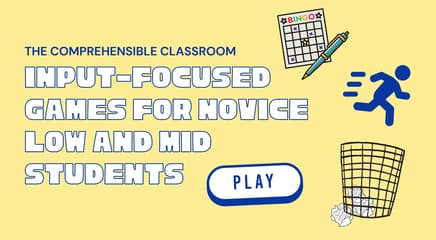I needed to spend today prepping vocabulary for Chapter 2 of El Nuevo Houdini with my Spanish 2 students. There are a few words in the chapter that are important to the understanding of the chapter with which my students are not yet familiar, or might have trouble recognizing. For example, most of them have a hard time distinguishing the difference in meaning between preterite and imperfect verbs. When they see the verb "dormía", they might say "he slept" (incorrect) or "he was sleeping" (correct)...some may even try to say "he's sleeping". They haven't yet seen enough -ía endings to fully acquire the idea that it signifies a repeated or ongoing action in the past (he used to __ or was __ing). So, all that to say we had to do a little vocabulary work.
In a 'traditional' language classroom, this would be easy enough: give the students a list of vocabulary terms and do any number of activities to practice them: read/translate sentences, fill in blanks in conversations, do crossword or other puzzles, etc. But none of these activities give me the high number of contextualized repetitions for which I aim in my comprehensible input classroom. This is also for my "Plan B" class (no longer on Plan B, but I don't want to let the reigns out too far just yet!), so throwing the terms out there for discussion is still scary to me. Furthermore, it's important that we always keep our students guessing and not use the same activities for the same purposes week after week. Sheesh! It's hard work being a teacher, eh? So this week I settled on Mad Libs.

The part that I DON'T like is that it really is necessary to use grammar-speak in the first part of the activity, because verbs and nouns and other things need to be in a certain form in order to fit correctly into the story. I handle this annoyance by writing out the grammar speak on the page, but then explaining to students (in Spanish) as we go through each step "definite article, that means you can't say "house", you have to say "the house"; you can't say dog, you have to say "the dog". 3rd person singular preterite action verb....that means it has to be an action that someone did in the past...it couldn't be runs, it would have to be ran. It couldn't be felt because that's not an action...etc. Explain your way through the grammar speak, and you'll find that you get some nice input along the way.
The part that I DO like is that I now have 30 versions of the same reading, each of which has multiple repetitions of the structures that I want to target. In this case, it was 'dormía', 'tocó', 'quedarse' (and other forms of that verb) and 'irse' (se fue). We can read and discuss several versions, personalize them, compare and contrast them, combine them, change them, expand them to create embedded readings...the sky is the limit!
To create the Mad Lib, I simply wrote a list of the structures that I wanted to target and wrote a quick story that included them in as few sentences as possible. Then, I went back and looked for ways to repeat the structures by adding more details to the plot. Today, we read several versions--targeting my key structures with personalized questions and circling in discussion--then students paired up and compared and contrasted their two versions with a Venn Diagram. Finally, I looked for ways that I could change or expand the reading to include other structures that we have recently studied (conducir, podía, venir) so that I could get in more repetitions of them, as well. Before I distributed it to my students, I went through and did the Mad Lib myself to make sure that it all matched up and that my instructions for the first part were specific enough. I've attached the finished product here, and you are welcome to use it! Again, I created it to meet my class's specific instructional needs, so it won't be a perfect match for your needs. In that case, feel free to use it as a fun activity anytime during your study of El Nuevo Houdini!
What activities do YOU use in your classrooms to get in some good reps of new/unfamiliar vocabulary for when you are preparing to read a chapter in a novel?




